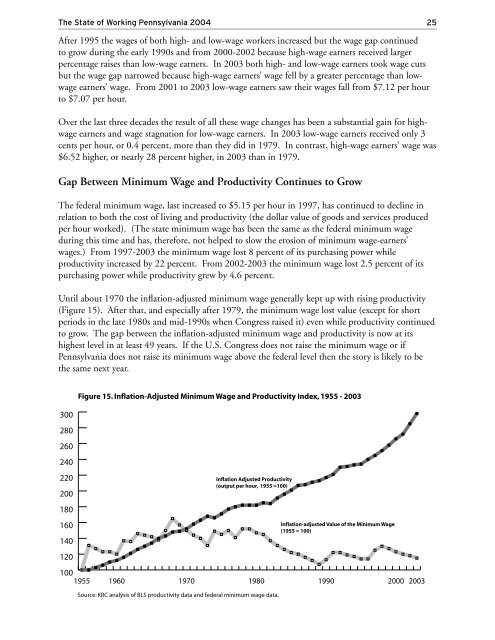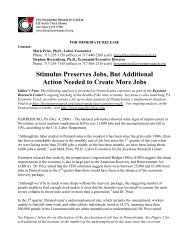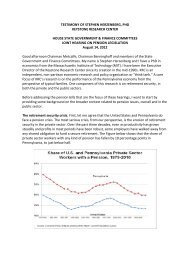The State of Working Pennsylvania 2004 - The Keystone Research ...
The State of Working Pennsylvania 2004 - The Keystone Research ...
The State of Working Pennsylvania 2004 - The Keystone Research ...
You also want an ePaper? Increase the reach of your titles
YUMPU automatically turns print PDFs into web optimized ePapers that Google loves.
<strong>The</strong> <strong>State</strong> <strong>of</strong> <strong>Working</strong> <strong>Pennsylvania</strong> <strong>2004</strong> 25<br />
After 1995 the wages <strong>of</strong> both high- and low-wage workers increased but the wage gap continued<br />
to grow during the early 1990s and from 2000-2002 because high-wage earners received larger<br />
percentage raises than low-wage earners. In 2003 both high- and low-wage earners took wage cuts<br />
but the wage gap narrowed because high-wage earners’ wage fell by a greater percentage than lowwage<br />
earners’ wage. From 2001 to 2003 low-wage earners saw their wages fall from $7.12 per hour<br />
to $7.07 per hour.<br />
Over the last three decades the result <strong>of</strong> all these wage changes has been a substantial gain for highwage<br />
earners and wage stagnation for low-wage earners. In 2003 low-wage earners received only 3<br />
cents per hour, or 0.4 percent, more than they did in 1979. In contrast, high-wage earners’ wage was<br />
$6.52 higher, or nearly 28 percent higher, in 2003 than in 1979.<br />
Gap Between Minimum Wage and Productivity Continues to Grow<br />
<strong>The</strong> federal minimum wage, last increased to $5.15 per hour in 1997, has continued to decline in<br />
relation to both the cost <strong>of</strong> living and productivity (the dollar value <strong>of</strong> goods and services produced<br />
per hour worked). (<strong>The</strong> state minimum wage has been the same as the federal minimum wage<br />
during this time and has, therefore, not helped to slow the erosion <strong>of</strong> minimum wage-earners’<br />
wages.) From 1997-2003 the minimum wage lost 8 percent <strong>of</strong> its purchasing power while<br />
productivity increased by 22 percent. From 2002-2003 the minimum wage lost 2.5 percent <strong>of</strong> its<br />
purchasing power while productivity grew by 4.6 percent.<br />
Until about 1970 the inflation-adjusted minimum wage generally kept up with rising productivity<br />
(Figure 15). After that, and especially after 1979, the minimum wage lost value (except for short<br />
periods in the late 1980s and mid-1990s when Congress raised it) even while productivity continued<br />
to grow. <strong>The</strong> gap between the inflation-adjusted minimum wage and productivity is now at its<br />
highest level in at least 49 years. If the U.S. Congress does not raise the minimum wage or if<br />
<strong>Pennsylvania</strong> does not raise its minimum wage above the federal level then the story is likely to be<br />
the same next year.







